#verilog deep learning
Explore tagged Tumblr posts
Text
Paving the Path to VLSI Success: A Deep Dive into Learning Opportunities
The Rising Demand for VLSI Professionals
In today’s technology-driven world, the demand for skilled professionals in the field of Very-Large-Scale Integration (VLSI) continues to surge. VLSI technology forms the foundation of most modern electronic devices, from smartphones to satellites. As integrated circuits become more complex, the need for engineers who can design, test, and improve these systems grows. Engineering students and electronics graduates looking to future-proof their careers are increasingly drawn to VLSI as a specialization. Companies in India and around the world are on the lookout for talent equipped with practical VLSI skills, making this an attractive career path. Given this scenario, educational institutions and private training centers have stepped up to provide in-depth programs designed to meet industry needs. Aspiring engineers now have a variety of options to choose from when selecting the right program to build their foundation in VLSI technology.
Importance of Industry-Relevant Training in VLSI
While a formal degree in electronics or electrical engineering provides the basics, industry-relevant training in VLSI is critical for practical success. This is because VLSI is highly application-based, demanding a strong understanding of design tools, programming languages, and testing methodologies. Hands-on experience with CAD tools, simulation software, and real-time projects can make all the difference. As a result, the choice of a training institute becomes an important factor. Students looking to enter this domain often search for the top vlsi institutes in hyderabad, as Hyderabad is a major technology hub with several reputed centers offering quality training. These institutes focus on practical exposure, experienced faculty, and placement support, all of which are key to student success. With proper guidance and the right learning environment, students can gain the skills required to thrive in this competitive field.
Choosing the Right VLSI Course
Selecting the right VLSI course is essential for aligning one's career goals with market expectations. The ideal course not only covers theoretical knowledge but also emphasizes real-world application. Curriculum components typically include digital design, CMOS technology, Verilog/VHDL, ASIC design, and FPGA implementation. Additionally, courses offering modules on SystemVerilog, UVM, and embedded systems are becoming increasingly popular. When evaluating course offerings, many prospective students explore vlsi courses in hyderabad to find a comprehensive program that covers both front-end and back-end design processes. It is important for learners to also consider the duration, mode of delivery (online/offline), and availability of project work. A structured course with industry-certified trainers and access to advanced lab setups can provide a valuable edge in this field. This clarity helps learners not only gain knowledge but also build a strong portfolio that can appeal to future employers.
Placement Support and Career Opportunities
One of the biggest advantages of enrolling in a reputed VLSI training program is the access to placement support. Leading institutes often have tie-ups with semiconductor companies, startups, and multinational corporations looking for trained professionals. Career opportunities in VLSI are vast, ranging from physical design engineers to verification specialists and DFT engineers. With the growth of IoT, AI, and 5G technologies, VLSI engineers are finding exciting roles in hardware development teams across domains. Institutes that focus on industry connections, mock interviews, resume building, and internships significantly boost a student’s employability. Moreover, alumni networks and mentorship programs help learners stay updated on trends and job openings. A combination of technical skills and soft skills training can greatly improve the likelihood of landing a dream role. As the semiconductor industry continues to grow, so too does the demand for qualified, hands-on VLSI professionals.
Conclusion: Begin Your VLSI Journey with Confidence
Choosing the right institute and course is the first step toward a successful VLSI career. From understanding the fundamentals to mastering design and verification tools, a structured training program can be a game changer. Whether you're a fresh graduate or a working professional looking to switch domains, VLSI offers a dynamic and rewarding path. Hyderabad, as a tech hub, continues to provide ample opportunities for learning and growth in this field. Institutes that combine practical training, expert mentorship, and placement assistance can help bridge the gap between education and employment. If you're looking to start or elevate your career in this domain, takshila-vlsi.com is a reliable place to begin your journey.
0 notes
Text
Mastering VLSI Design: The Path to a Promising Career in Semiconductor Industry
The Rising Demand for VLSI Professionals
The semiconductor industry is experiencing a dramatic shift, powered by the growing demand for smaller, faster, and more efficient chips in everything from smartphones to electric vehicles. Very-Large-Scale Integration (VLSI) design plays a critical role in this transformation, enabling the integration of millions of transistors onto a single chip. As technology continues to evolve, the need for skilled VLSI engineers is expanding at an unprecedented rate. This demand has opened up a world of opportunities for those interested in chip design and semiconductor engineering. Companies worldwide are investing in VLSI talent to maintain a competitive edge, making this an ideal time for students and professionals to build a career in the field. Whether it’s designing system-on-chip (SoC) solutions or optimizing embedded systems, VLSI experts are becoming increasingly vital to the tech ecosystem.
Understanding the Fundamentals of VLSI Design
VLSI design involves the process of creating integrated circuits by combining thousands or even millions of transistors into a single chip. This complex engineering task requires a deep understanding of electronic circuit design, semiconductor physics, and design tools like Verilog, SystemVerilog, and VHDL. The curriculum in most vlsi training institutes includes modules on front-end and back-end design, logic synthesis, timing analysis, and verification methods. The end goal is to produce high-performance chips that are also power-efficient and cost-effective. VLSI engineers must possess strong analytical skills, a deep interest in electronics, and a passion for solving real-world problems. As technology nodes continue to shrink from 7nm to 3nm and beyond, the challenges in VLSI design grow more complex—demanding not just theoretical knowledge but also hands-on experience in state-of-the-art tools and practices.
Exploring Career Opportunities in VLSI
A career in VLSI is not only intellectually rewarding but also financially lucrative. From design engineers to physical design experts and verification engineers, the job roles in this domain are diverse and highly specialized. Each position plays a crucial part in bringing a semiconductor product from concept to fabrication. What makes VLSI especially appealing is the steady demand from both startups and tech giants involved in AI, IoT, and 5G innovation. Particularly in India, the ecosystem around semiconductor design is growing, creating an urgent need for competent professionals. The rise of online vlsi training institutes in bangalore has made it easier for aspiring engineers to access high-quality education and training without geographical constraints. With remote learning tools, recorded sessions, and access to simulators, these platforms are revolutionizing how VLSI education is delivered, allowing learners to gain industry-relevant skills from the comfort of their homes.
Key Skills and Tools Every VLSI Engineer Should Learn
To thrive in the VLSI domain, aspiring engineers must master a combination of technical skills and practical tools. On the technical side, knowledge of digital electronics, CMOS design principles, and signal integrity is foundational. On the software front, proficiency in EDA (Electronic Design Automation) tools like Cadence, Synopsys, and Mentor Graphics is a must. Additionally, scripting languages such as Perl, Python, and Tcl are used to automate repetitive design and verification tasks. Industry expectations are high, and candidates are often evaluated not just for their academic background but for their problem-solving ability, project experience, and understanding of real-time design constraints. VLSI is a continuously evolving field, and engineers must commit to lifelong learning to stay ahead. Regularly updating one’s knowledge through webinars, certifications, and self-guided projects is crucial to success in this fast-paced industry.
Choosing the Right Institute for VLSI Training
Given the complexity and depth of the VLSI field, selecting the right training institute becomes a vital step in one’s professional journey. The ideal institute offers a blend of theoretical instruction and practical exposure, mentored by industry veterans. It should provide access to real-world design tools, capstone projects, and placement support. Moreover, flexibility in learning schedules and a structured curriculum aligned with industry requirements can make a significant difference. One such platform that offers all these features is takshila-vlsi.com, a trusted name in the VLSI education space. With a commitment to quality and innovation, Takshila VLSI equips learners with the skills needed to succeed in the semiconductor industry, bridging the gap between academic knowledge and practical application.
0 notes
Text
Advance Your Career with RTL Verification Training at Takshila Institute of VLSI Technologies
RTL (Register Transfer Level) Verification is a fundamental process in the VLSI design flow. It involves checking the logic and functionality of a digital circuit design described in a hardware description language such as Verilog or VHDL. The goal is to ensure the design behaves as intended before it moves to synthesis and physical implementation. RTL verification includes writing testbenches, performing simulation, and applying assertions and coverage metrics to validate the design thoroughly. As VLSI designs grow in complexity, efficient RTL verification becomes essential to catch logical bugs early in the design cycle, saving time and cost.
Importance of RTL Verification Training
With the increasing demand for faster and more reliable chips, companies are investing heavily in design verification. As a result, RTL verification engineers are among the most sought-after professionals in the semiconductor industry. However, becoming a proficient verification engineer requires deep knowledge of digital design, verification methodologies like UVM (Universal Verification Methodology), and hands-on experience with simulation tools. This is where structured training plays a crucial role. High-quality RTL verification training helps learners bridge the gap between academic theory and industry practice.
A Leading Training Institute in Hyderabad
For those seeking specialized RTL verification training in Hyderabad, the Takshila Institute of VLSI Technologies is a trusted name in India. The institute is renowned for its focused curriculum, experienced trainers, and strong industry connections. Takshila's RTL verification program is carefully designed to meet current industry standards, incorporating both theoretical concepts and hands-on lab sessions.
The training includes modules on SystemVerilog, functional simulation, UVM-based environments, and testbench development. Participants also get exposure to real-time projects and debugging techniques using industry-standard tools. The institute ensures that students develop a strong foundation and are job-ready upon course completion.
Why Choose Takshila Institute in Hyderabad?
Among RTL verification training institutes, Takshila Institute of VLSI Technologies in Hyderabad stands out due to its quality of instruction, practical learning approach, and placement support. The institute not only trains students in technical skills but also prepares them for interviews and real-world challenges through mock tests and industry interaction sessions.
With a consistent track record of successful placements in leading semiconductor companies, Takshila is the ideal destination for aspiring RTL verification engineers. Whether you are a fresh graduate or a working professional aiming to shift into VLSI, this institute provides the right guidance and support to help you succeed.
0 notes
Text
Master ASIC Design and Verification Training Today

In today’s fast-paced semiconductor industry, mastering ASIC (Application-Specific Integrated Circuit) design and verification is essential for engineers and professionals looking to advance their careers. With cutting-edge technology and increasing demand for customized chip designs, the need for skilled ASIC designers is greater than ever. If you are eager to enhance your expertise, ASIC Design and Verification Training is the perfect opportunity to gain in-depth knowledge and practical skills.
Why Choose ASIC Design and Verification Training?
ASIC design is a complex yet rewarding field that requires a deep understanding of digital circuits, system architecture, and verification methodologies. This training equips you with:
Fundamental and Advanced ASIC Design Concepts – Learn the principles of ASIC development, from design to implementation.
Verification Techniques – Master simulation-based verification, formal verification, and functional testing.
Industry-Standard Tools – Get hands-on experience with tools like Verilog, VHDL, SystemVerilog, and UVM.
Practical Projects and Case Studies – Work on real-world projects to strengthen your problem-solving abilities.
Expert Guidance – Learn from industry professionals with years of experience in ASIC design and verification.
Who Should Enroll?
This training is ideal for:
Engineering students and graduates looking to specialize in VLSI and ASIC design.
Working professionals aiming to upskill in semiconductor design.
Anyone passionate about learning digital design and verification methodologies.
Career Benefits of ASIC Design and Verification Online Training
With expertise in ASIC design and verification, you can unlock various career opportunities in semiconductor and electronics industries. Job roles include:
ASIC Design Engineer
Verification Engineer
FPGA Engineer
VLSI Design Engineer
Embedded Systems Engineer
Enroll Today and Advance Your Career!
Don’t miss the chance to boost your career in the high-demand field of ASIC design. Join ASIC Design and Verification Training today and gain the skills needed to thrive in the semiconductor industry. Start your journey towards success with expert-led training and hands-on experience.
At Multisoft Virtual Academy, we provide comprehensive training programs to help tech enthusiasts achieve professional excellence. Sign up now and take the next step in your career!
0 notes
Text
System Verilog for Functional Verification – Inskill Courses
In today’s semiconductor industry, functional verification is crucial for ensuring reliable, high-quality VLSI design. Among the tools and methodologies available, SystemVerilog stands out as the most advanced and versatile hardware description and verification language. At Inskill, our SystemVerilog for Functional Verification course is tailored to help learners gain a competitive edge in this critical domain.

Why SystemVerilog for Functional Verification?
SystemVerilog combines the strengths of Verilog with modern features designed for robust verification processes. It enables seamless testbench development, functional coverage analysis, and efficient debugging of complex designs. Features like randomization techniques, procedural blocks, and interfaces make it the go-to language for designing testbenches in compliance with the UVM (Universal Verification Methodology).
Course Highlights
At Inskill, our course bridges the gap between academic learning and industry demands by offering:
Comprehensive training in SystemVerilog syntax and features.
Deep dives into testbench development, UVM, and functional coverage concepts.
Hands-on projects simulating real-world scenarios to build practical expertise.
Expert guidance from seasoned VLSI professionals.
Who Can Benefit?
Whether you are a fresh graduate, an aspiring VLSI engineer, or a working professional, this course will equip you with the knowledge and skills needed to advance your career. Learn how to develop robust verification environments and debug complex designs with confidence.
Why Choose Inskill?
Inskill is known for its industry-relevant courses that focus on advanced training, hands-on learning, and career-oriented skills. Our SystemVerilog for Functional Verification program ensures learners are industry-ready, making them valuable assets in the semiconductor industry.
Take the Next Step
Functional verification is a growing field with high demand for skilled engineers. Enroll in Inskill’s SystemVerilog for Functional Verification course today to master in-demand skills and accelerate your career in the semiconductor industry!
0 notes
Text
What is the Scope of the VLSI Internship?
Have you ever Heard of VLSI? If not, you must if you are an aspiring engineering student or already studying or someone who has a deep interest in electronics, semiconductors, or chips. VLSI stands for Very-large-scale integration, and this term has been around since 1970. This field is related to integrated circuits and chips. Using VLSI, thousands of transistors get integrated into one chip. Microprocessors and chips are everywhere—mobile phones, electronics, computers, laptops, robots, and more use VLSI-based microprocessors. Therefore, the demand for professional; engineers under VLSI is enormous.
So, is it worth considering VLSI as a career? The answer is very much. Especially if you desire not to work in a routine engineering position, VLSI could be a good choice for you. VLSI professionals generally have electronics and electrical engineering backgrounds. However, software programmers designing VLSI chips use hardware description languages (HDLs) like VHDL and Verilog. Therefore, engineers from computer science backgrounds can make a terrific career if they have strong semiconductor physics and software programming knowledge. One can get an added advantage if the person is equipped with good communication skills.
What are the Career Options for VLSI Professionals?
There are multiple types of job roles under which VLSI
professionals can make their career, and below are the details:
1. VLSI design engineer:
As the designation name implies, the job duty includes design implementation. There are subdomains under design that have been created as per technologies subsets like DFT (Design for the test), PCB-Board Design, and Custom Design - Transistor level. Both front-end and back-end designers are in demand in design profiles.
2. Verification engineer in VLSI
A verification engineer does the job of performing verification during the whole manufacturing process of chips. They are responsible for ensuring that the design is working as per expectations and performing verification.
Subdomain of verification engineers:
● Hardware-software verification
● The product validation process, Behavioural modeling
● Acceleration / Emulation validation
3. Application engineer
In this role, you are responsible for interacting with customers and R&D. This work profile requires excellent interpersonal skills and extensive travel. This job would be a good fit for someone who is excellent at communication, a good presenter, able to build relationships, and knowledgeable about technology. Those with a keen interest in sales or marketing can quickly become marketing or sales executives and manger while working as VLSI application engineers.
Sub-domains of Application Engineers:
● Pre-sales Field Application Engineer
● Post-sales Engineer for Corporate Applications
● Consultants for application
4. CAD Engineer
CAD engineers is another profile for VLSI engineers. Under this profile, they need to perform different steps to automate parts of the design flow.
CAD engineers must be well-versed in the entire design process from specifications to delivery. It is essential to master EDA tools, scripts, and quality assurance for them.
5. Corporate Application Engineer (CAE)
CAEs write knowledge-based articles, create user guides, and conduct webinars as part of their responsibilities. Sales and marketing teams typically collaborate closely with them. The FPGA is a customized device. Good communication skill is another desired skill set in it.
Salaries of VLSI engineers:
The average annual salary of a VLSI engineer can be between INR 5 Lakhs to INR 6 Lakhs, depending upon the job role, experience, and exposure.
Why Take VLSI Internship?
Through VLSI internships, engineering students can acquire in-demand technical skills. Furthermore, it enhances professional ethics and the development of soft skills. It is an opportunity for students to learn about the real world of work in contrast to theory. It is even more critical for VLSI aspiring students since their job is highly technical and involves a lot of bits. if you are looking to earn VLSI internship in Bangalore, Maven Silicon VLSI Training Center is a perfect option.
0 notes
Text
Arc Download Mac


Gis For Mac
Free Download Arcgis 9.3 Software
Ark Download Mac
Ark Download Manager
If your new or existing Anthem, Paradigm, or MartinLogan product is ARC or PBK enabled*, you can experience a new level of room correction technology and convenience by downloading ARC Genesis software. * ARC Genesis is not compatible with older products that rely solely on RS-232 connections for data transmission. For legacy product support, please download ARC-1 software.
About This Game As a man or woman stranded naked, freezing and starving on the shores of a mysterious island called ARK, you must hunt, harvest resources, craft items, grow crops, research technologies, and build shelters to withstand the elements. Explore immersive news content, game enhancing challenges and exclusive rewards through Arc for free. Arc gives you inside access with in-depth content showcases, player spotlights, event calendars, and more! Be delighted with free items and giveaways for your games and challenge yourself by accumulating points that can be cashed in for epic rewards. This application supports English.
New Features Include:
Gis For Mac
Support for Mac & Windows
New target curve adjustment options, including deep bass and high frequencies
Save, stop, start, resume measurements, and remeasure individual speakers
Improved user interface
Improved algorithms
Set unique maximum correction frequencies for each set of speakers
Automatic speaker/subwoofer phase alignment for Anthem STR Series products
How does ARC work?
An audio system’s performance is always negatively affected by a room’s unique characteristics. The size and shape of the room, its construction, the furnishings, and other factors cause standing waves, resonances, and reflections that can color the sound played by loudspeakers. Utilizing proprietary algorithms developed by Anthem engineers, ARC Genesis creates custom correction curves that retain the favorable acoustic signature of speakers and remove negative room contributions. These custom filters are then used to program high-quality digital signal processing (DSP) technology embedded within compatible audio products.
Click the button below to download Arq Backup: Download Arq 6 for Windows or Get Arq 6 for Mac; Double-click Arq6.msi in your Downloads folder to install Arq. When Arq launches, enter your email address and click Start Trial (or click Enter License Code if you already have a license code). Click 'Create a new backup plan'.
Advanced REST Client comes with 3 preinstalled themes: light, dark and Anypoint. Thanks to open standards and ARC's open architecure you can create your own theme and distribute it within your organization.
What do I need to install ARC Genesis?
Download ARC Genesis
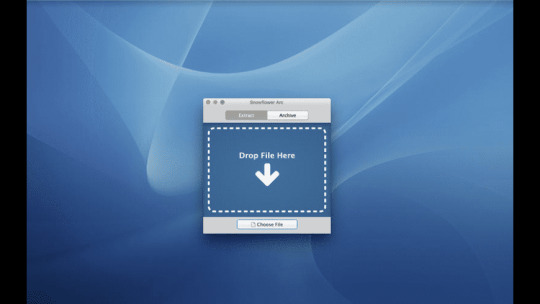
For Mac or PC Windows = 7/8/8.1/10 Mac OSX = 10.12 +
Expanded Compatibility
ARC Genesis® is backward compatible with many Anthem, Paradigm, or MartinLogan products that are ARC or PBK enabled (see full list of compatible products below). Mac os x lion 10.7 dmg free download. This third generation of ARC represents a major leap forward in room correction with the most comprehensive features ever. ARC Genesis transforms the audio performance of compatible speakers or electronics to the unique characteristic of any room. Proprietary Digital Signal Processing (DSP) software works in tandem with the calibrated microphone provided with your ARC enabled product to provide an astonishing improvements to the sound you hear.
ARC Genesis Compatible Products:
AVM 60
MDX-16 / 8
MRX Gen 2 (710 / 510 / 310)
MRX Gen 3 (1120 / 720 / 520)
STR Integrated / Preamplifier
ARC Genesis Compatible Products:
Defiance V12 / V10
Defiance X15 / X12 / X10
Millenia SUB
Persona 9H / SUB
Prestige 2000SW / 1000SW
PW 800 / 600 / AMP / LINK / Soundbar
Seismic 110
Soundplay
X-850
ARC Genesis Compatible Products:
BalancedForce 212 / 210
Bravado / Cadence / Forte / Unison / Verse
Dynamo 1600X / 1500X / 1100X / 800X / 600X
Expression ESL 13A
Illusion ESL C34A
Impression ESL 11A
MDA16 / 8
Renaissance ESL 15A
ARC Genesis Key Features
Demo Mode: Experience the software first hand. Demo mode offers access to the full suite of tools without having an Anthem, MartinLogan, or Paradigm compatible product connected.

Assign Amp Channels: For products such as Anthem’s MRX audio/video receivers and AVM home theater processors, ARC Genesis allows you to configure the assignable amp channels from within the software, making quick work of setting up your receiver for zone 2 or height effects channels.
Set Up Bass Management: For products such as Anthem’s MRX audio/video receivers, AVM home theater processors, and STR preamplifier and integrated amplifiers, ARC Genesis not only optimizes the performance of your system, it also lets you set up bass management from within the software. To redirect bass to a subwoofer (below a speaker’s Crossover frequency), set the Send Bass to Subwoofer (or Low-Frequency Extension Slope) control to “Send bass to the sub.”
Customize Target Curves: With ARC Genesis’ Professional Mode, the target curves for the system as a whole, are adjustable using room gain, deep bass boost, and tilt controls. Individual sets of speakers allow for the adjustment of high-frequency roll-off and crossover frequencies and slopes. Subwoofers allow for the adjustment of high-frequency extension, low-frequency extension, and low-frequency extension slope.
20 Hz to 20,000 Hz Full-Range Room Correction for Each Set of Speakers: For products such as Anthem’s MRX audio/video receivers, AVM home theater processors, and STR preamplifier and integrated amplifiers, ARC Genesis allows you to set a different maximum correction frequency for each set of speakers, up to 20,000 Hz. For example, you may want to use room correction on your dipole electrostatic front speakers up to 400 Hz and your small in-ceiling height effect speakers up to ARC’s default of 5,000 Hz.
Multiple Measurements: Some devices allow you to create multiple measurement sets (up to four, depending on the device). We recommend more than one if some significant transformation predictably takes place within the room that can alter the room’s acoustic response. For example, take one set of measurements with a drop-down video screen deployed and another with the screen hidden, drapes up or down, doors open or closed, and so on.
Multiple Profiles: Alone in the dark mac download. Some devices allow you to create multiple system profiles (up to four, depending on the device). For example, one profile can optimize your system as a multi-channel home theater with sub and another as a 2-channel music system without a sub. Can't transfer photos from iPhone to … - Apple Community.
Remeasure: If you’ve spent time working with ARC to dial in the performance of your system and later decide to upgrade your center channel or another speaker, ARC Genesis allows you to open a saved configuration file, remeasure only your new speaker, and update your target curves without needing to start over from scratch.
Pan and Zoom: ARC Genesis allows you to examine graphs in great detail. To zoom on a computer, place your cursor over the graph and spin your mouse wheel or choose Zoom In or Zoom Out. To pan on a computer, left-click on a graph and drag it to change position. On a touch screen enabled device, you press the Zoom In or Zoom Out controls or press and drag to pan.
Multiple Languages: Support for several languages is available under ARC > Preferences > Languages. To switch to a different language, select your preferred language from the Preferences panel, close the application, and restart it. At the time of launch, ARC supports Chinese, English, French, German, and Spanish.
Free Download Arcgis 9.3 Software
Quick Measure and Snapshots: Quick Measure allows you to experiment with speaker and subwoofer positioning and settings outside of ARC while monitoring the resulting acoustic response in real time. The snapshot feature allows you to freeze a curve to compare against subsequent changes that affect the acoustic response.

ARC: Frequently Asked Questions
Advertisement
Arc Consistency Crossword Compiler v.0.1Arc Consistency Crossword Compiler (arccc) uses constraint satisfaction algorithms to fill crossword grids given a wordlist. The current implementation can fill simple grids in less than a minute. A word list gleaned from a variety of sources is ..
MegaMensurationX v.1.3MegaMensurationX 1.3 is a beneficial and highspeed software for teaching and learning of mensuration. Includes perimeter and area of rectangles, squares, parallelograms, triangles and trapeziums, circumference and area of circles, arc lengths and ..
SimCity 4 Landmarks v.1.0SimCity 4 Landmarks is a Sim City 4 city add-on. It allows you to add notable, real-world architecture to your cities! Includes TheMayflower, Seoul Soccer Stadium, the Parthenon, the Bradenburg Gate, theCapitol Records Building, the Arc de ..
First Cuts Studio for Mac OS v.1.5Log your clips into bins in Final Cut Pro; pass the bins to First Cuts and get back a fast first cut immediately, with story arc, b-roll and lower thirds. Never face the frustration of an empty sequence again - explore story content as a series of ..
Covered v.0.7.10Covered is a Verilog code coverage utility using VCD/LXT/FST dumpfiles (or VPI interface) and the design to generate line, toggle, memory, combinational logic, FSM state/arc and assertion coverage report metrics viewable via GUI or ASCII ..
Faerie Queene Online - NWN2 v.3Based on Edmund Spensers The Faerie Queene, using Neverwinter Nights 2. Participants collaboratively compose a story arc, including character dialogues and quests, based on The Faerie ..
Combat Mission: Barbarossa to Berlin v.1.0.3Combat Mission: Barbarossa to Berlin 1.0.3 is a game which is considered as the revolutionary successor to the award winning game system pioneered in Combat Mission: Beyond Overlord. Bigger, bolder, larger in scope with layers of more detail, it is ..
Iota-calciota-calc is a useful and effective calculator that is designed for Mac OS. It supports the Input/Output Formats: Binary, Octal, Decimal, Hexadecimal, Booleans, Characters, UTF-8 (out only), UTF-16 (out only) and convert automatically between these ..
Sweet Home 3D v.3.4Sweet Home 3D is a free interior design application that helps you place your furniture on a house 2D plan, with a 3D preview. Sweet Home 3D helps you to design your interior quickly and easily: draw the walls of your home upon the image of an ..
Iota-calc for Mac OS X v.1.8.5.0FEATURES: Supports a rich expression format, which is in most cases identical to what you would type in your programming language. Support for adding an unlimited number of variables. Built-in debugger that lets you see the expression simplified ..
Travelogue 360 Paris for Mac OS v.1.0Among its renowned landmarks and hidden gems waiting to be discovered, Paris holds something new for each of its visitors. Scour some of the worlds most famous locations for souvenirs as you prepare to be interviewed for an upcoming article in ..
TurboCAD MAC Deluxe 2D/3D for Mac OS v.5.0Makes it easy to design anything. Snap to x, y coordinates to quickly layout floorplans, diagrams and more with the complete set of 2D design tools. The new freehand spline gives you maximum drawing freedom while the new fair curve tool lets you ..
Flash TShirt Design Software v.4.0Products Designer custom T-shirt design is the ultimate solution for starting your custom online T-shirt design printing website. Our software gives your user a guaranteed, easy way to design own t-shirts. Online tee shirt designer satisfies the ..
GLE for Mac OS X v.4.2.4GLE (Graphics Layout Engine) is a graphics scripting language designed for creating publication quality graphs, plots, diagrams, figures and slides. GLE supports various graph types (function plots, histograms, bar graphs, scatter plots, contour ..
AnyChart Stock and Financial Flash Chart v.1. 1. 2000AnyChart Stock Component is a fully functional solution for solving the broadest range of data visualization problems. The component has numerous advantages over similar software, which excel it as a unique stock and financial charting solution on ..
PyTectonics v.1.0PyTectonics is a 3d plate tectonics simulator written in Python to provide realistic terrain generation for hobbyist world builders. PyTectonics seeks to use simple yet scientifically defensible models to simulate plate motion. Mechanistic ..
DXF Export Java v.7Cross-platform developer Java library for exporting CAD entities and data to AutoCAD DXF with ease.
VeryPDF PDF Annotator Framework SDK for iOS v.2.1VeryPDF PDF Annotator Framework SDK for iOS is an Objective-C framework to annotate PDF documents on the fly from any iOS (iPhone and iPad) application. The framework does not rely on any 3rd party products for PDF annotation.
Today's Top Ten Downloads for Arc
Ark Download Mac
Flash TShirt Design Software Products Designer custom T-shirt design is the ultimate
GLE for Mac OS X GLE (Graphics Layout Engine) is a graphics scripting
Sweet Home 3D Sweet Home 3D is a free interior design application that
TurboCAD MAC Deluxe 2D/3D for Mac OS Makes it easy to design anything. Snap to x, y coordinates
AnyChart Stock and Financial Flash Chart AnyChart Stock Component is a fully functional solution for
VeryPDF PDF Annotator Framework SDK for iOS VeryPDF PDF Annotator Framework SDK for iOS is an
Travelogue 360 Paris for Mac OS Among its renowned landmarks and hidden gems waiting to be
DXF Export Java Cross-platform developer Java library for exporting CAD
Combat Mission: Barbarossa to Berlin Combat Mission: Barbarossa to Berlin 1.0.3 is a game which
SimCity 4 Landmarks SimCity 4 Landmarks is a Sim City 4 city add-on. It allows
Ark Download Manager
Visit HotFiles@Winsite for more of the top downloads here at WinSite!

1 note
·
View note
Text
Lead II - Data Analysis
Lead II – Data Analysis
Lead II – Data Analysis #OmAccounting.in #GstAccounting #GstReturns #accountingServices #accountingOutsoucing #onlineAccounting #gstecommerceaccounting Details: Technical Skills: Programming Languages: Python; Matlab; VHDL; Verilog Machine Learning: Deep Neural Networks; Keras; Scikit-learn; OpenCV; NLTK; S… Source: careerbuilder
View On WordPress
0 notes
Text
The Growing Demand for VLSI Training and Career Opportunities
The Importance of VLSI in the Semiconductor Industry
The field of Very Large Scale Integration (VLSI) has seen exponential growth in recent years, driven by the rapid advancements in semiconductor technology. With the ever-increasing demand for high-performance chips used in smartphones, computers, automotive electronics, and artificial intelligence, VLSI has become a crucial aspect of modern electronics. The need for skilled professionals in this domain is rising, leading to the emergence of specialized training institutes that equip students with the necessary knowledge and hands-on experience. Engineers with expertise in VLSI design and verification are highly sought after by global technology firms, making this an attractive career path for aspiring electronics engineers.
Skills and Knowledge Required for a Career in VLSI
A successful career in VLSI requires a deep understanding of digital design, analog and mixed-signal design, system-on-chip (SoC) architecture, and verification methodologies. Programming skills in hardware description languages like VHDL and Verilog are essential, along with expertise in Electronic Design Automation (EDA) tools. The learning curve for VLSI professionals is steep, as it involves both theoretical concepts and practical applications. Many engineers and students opt for professional training programs to bridge the gap between academic knowledge and industry expectations. In particular, enrolling in one of the top 10 VLSI training institutes can provide a strong foundation and industry exposure, helping individuals stay ahead in this competitive field.
The Role of Training Institutes in Shaping VLSI Professionals
VLSI training institutes play a significant role in preparing students for real-world industry challenges. These institutes offer comprehensive courses covering fundamental to advanced topics, ensuring that learners gain practical expertise. Training programs often include hands-on projects, industry-relevant case studies, and internship opportunities that enhance problem-solving abilities. Many training centers collaborate with semiconductor companies, providing students with valuable networking opportunities and job placements. Among the many options available, VLSI institutes in Bangalore are particularly renowned for their high-quality education and strong industry connections. As Bangalore is a hub for semiconductor companies, students trained here have a higher chance of securing rewarding job opportunities.
Career Opportunities and Future Scope in VLSI
With the rapid expansion of the semiconductor industry, the demand for skilled VLSI engineers continues to grow. Companies specializing in chip design, manufacturing, and embedded systems actively seek trained professionals who can contribute to the development of cutting-edge technologies. Career opportunities in this field are diverse, ranging from digital and analog design to verification and testing. Additionally, with the emergence of AI, IoT, and 5G, the scope for VLSI professionals is expanding further. Salaries in this domain are highly competitive, and individuals with specialized training can secure lucrative positions in leading global technology firms. Those who continue upgrading their skills and staying updated with industry trends will find themselves at the forefront of technological advancements.
Choosing the Right VLSI Training Institute
Selecting the right training institute is a crucial step in building a successful career in VLSI. Factors such as faculty expertise, course curriculum, industry collaborations, hands-on training, and placement assistance should be carefully evaluated before making a decision. Institutes that offer mentorship, real-time project exposure, and certification programs can significantly enhance a student’s career prospects. One such institute that has gained recognition for providing quality VLSI training is Takshila VLSI.com. By enrolling in a reputed training institute, aspiring VLSI professionals can equip themselves with the necessary skills and knowledge to excel in the semiconductor industry.
0 notes
Text
Mastering VLSI: Your Guide to Industry-Ready Chip Design Skills
Understanding the Importance of VLSI in Today’s Tech Industry
The world of technology is rapidly advancing, and at the heart of these developments lies VLSI (Very Large Scale Integration) design. This intricate process enables the creation of complex semiconductor devices used in everyday gadgets, computers, and communication systems. As innovation surges, the demand for skilled professionals in VLSI design continues to grow. Whether you are a student looking to start a career in electronics or an engineer seeking to specialize in chip design, building a strong foundation in VLSI is essential. Courses that offer practical exposure and a comprehensive curriculum are crucial for learners to understand and master this highly technical field. VLSI isn’t just about theory—it involves hands-on experience, a deep understanding of logic circuits, and a strong grasp of current industry trends, making high-quality training programs all the more critical.
Building Expertise with RTL Design Fundamentals
One of the key areas within VLSI is RTL (Register Transfer Level) design. RTL design focuses on describing the flow of data within a digital circuit using hardware description languages like Verilog or VHDL. A strong understanding of RTL is foundational for any aspiring VLSI engineer, as it plays a pivotal role in designing and simulating complex digital systems. Students and professionals who undergo rtl design training gain the ability to translate system-level functionality into hardware-level implementation, a skill highly valued in industries like semiconductor manufacturing, telecommunications, and embedded systems. As chip designs become more sophisticated, the need for precision and accuracy in RTL implementation continues to rise. Structured training programs help learners get familiar with design constraints, timing analysis, and synthesis, ensuring they are well-prepared for real-world design challenges.
Elevating Verification Skills with Online Training
Verification is another critical component of the VLSI design flow. It ensures that the design works as intended before it is fabricated into a physical chip. This step not only saves time but also prevents costly errors during production. With the rise of digital learning platforms, many engineers are turning to online design verification training to sharpen their skills from the convenience of their own space. These programs cover essential verification techniques such as simulation, formal verification, and coverage analysis. They also introduce learners to industry-standard tools and scripting languages, preparing them for practical scenarios in design environments. Online courses make it possible for working professionals and students to balance their schedules while still gaining the technical depth required to succeed in verification roles. As companies look for engineers who are both technically sound and time-efficient, this mode of learning continues to grow in popularity.
Advantages of Structured VLSI Training Programs
Choosing the right VLSI training program can have a lasting impact on your career. Structured courses not only offer a well-rounded curriculum but also provide hands-on lab sessions, mentorship, and real-time project experience. This type of immersive learning helps students to not just understand the theoretical aspects of VLSI but also to apply them in practical scenarios. Training programs with a strong emphasis on tools, techniques, and industry expectations can give learners an edge in job interviews and on the job. In addition to building technical expertise, such programs often include resume-building tips, mock interviews, and industry networking opportunities. By selecting a comprehensive training provider, learners can ensure that they are not only industry-ready but also confident in their ability to tackle the evolving challenges of the semiconductor world.
0 notes
Text
COMBINATION OF ASIC AND VLSI FOR BETTER JOB OPPORTUNITIES

ASIC Design and Verification training empowers the members to make contributions to ASIC (application-specific integrated circuit) corporation. ASIC is designed for a particular utility in preference to going for fashionable cause designing. This designing supports the improvement of embedded structures.
The curriculum is designed to impart the know-how and competencies for RTL (Register Transfer Level) designing and netlist generation. Participants exercise static time analysis (STA) for ASIC layout verification and validating the timing usual overall performance of the layout. The studying curve encompasses SOC designing and moreover specializes in HDL techniques for excessive overall performance designs intended for programmable precise judgment devices.
ASIC Verification Course Assignments & Labs:
Design an easy circuit in Verilog
Verification Environment for a simple layout
Creating Makefile
Final Project
Course Objectives:
Enables a profession jumpstart through developing deep expertise on ASIC Verification
Increase competitiveness via gaining experience with Verification ideas and strategies
Introduce Digital Design ideas and Verilog constructs
Build Verification environment for easy layout in Verilog
VLSI Course
Very-large-scale integration (VLSI) is the technique of making an integrated circuit (IC) with the aid of combining lots of transistors into an unmarried chip. In different words, an IC has many transistors on one chip, at the same time as VLSI has very many transistors on one chip. A present-day VLSI chip is a complicated beast with billions of transistors, hundreds of thousands of logic gates deployed for computation and control.
Engineers manipulate to layout those complicated chips by way of using computer aided design (CAD) tools that take a summary description of the chip, and refines it step-clever to a very last design. Designing a VLSI chip involves steps like logic synthesis, timing evaluation, floor planning, placement and routing, verification, and trying out.
VLSI Course and Its Scope
Select the route primarily based to your interest. If you're proper enough in programming then move for verification. Because in verification you have to deal with system verilog;UVM;OVM and so forth. If your semiconductor physics is powerful then cross for physical design. If you are interested by designing part then pass for memory design/widespread cell design. If you're exact sufficient in Analog then go along with analog layout design.Every discipline has precise significance in ASIC design glide. So, become aware of route and pick the course primarily based on it.
Benefits of VLSI design course
Confidence constructing up for IC Design Methodology
Fare knowledge of Digital Logic Design
Fare knowledge of FPGA Implementation
Experience of BEST learning exercise
Acquire abilities to do better Minor/Major Project
Can participate in numerous national/worldwide opposition and Techfest
VLSI stands for Very Large-Scale Integration. It is the technique of creating an Integrated Circuit (IC) by combining transistors or different devices right into a single chip.ICs are used in distinct forms of digital devices. Your cell smartphone includes ICs. An IC is a circuit in which all or a number of the circuit factors are inseparably associated and electrically interconnected in order that it is considered to be indivisible for the functions of construction and commerce.
0 notes
Link
RTL Coding and FPGA Design course has been designed to help to the beginners in the area of RTL coding and FPGA design. The course gives you the foundation for FPGA design in Embedded Systems along with practical design skills. By end of the course you will learn what FPGA, how to select the best FPGA architecture for a given application, solve critical digital design problems using FPGAs. As a part of the course, you will also learn to use FPGA development tools to complete several example designs, including a custom processor.
If you are thinking of a career in Electronics Design or as an engineer looking at a career change, this is a great course to enhance your career opportunities.
Eligibility
· B.E/B.Tech in ECE/EEE.
· M.E/M.Tech/M.S in VLSI/Embedded Systems/Digital Electronics.
Course Features and Highlights
· Deep understanding of digital logic design
· Knowledge of FPGA/ASIC design flow
· In depth knowledge of Verilog HDL – RTL coding & synthesis
· Fare understanding of creating power friendly RTL design
· Good understanding of FPGA implementation and debugging on Xilinx evaluation board.
· Acquire skills to do minor/major projects
· 24×7 Lab Support with Lab practice handouts and course material delivery.
· Industry standard project execution, Lab practice and theory sessions under the guidance of industry expert with 12+ years of experience.
· Soft skills development, complete suite of job oriented ASIC Verification training with 100% placement assistance.
FPGA Design Training Institutes, RTL Coding, RTL Design Training Institute, Verilog training Institute.
0 notes
Photo

nVidia open sources (!) deep learning processor hardware (Verilog and RTL) http://nvdla.org
1 note
·
View note
Text
JPEG Resize on-demand: FPGA vs GPU. Which is the fastest?
https://www.fastcompression.com/blog/jpeg-resize-on-demand-fpga-vs-gpu-performance-comparison.htmHigh performance image processing is essential task for web applications. It's not a rare situation when companies need to process hundreds of millions images every day. In some services that number could reach several dozens of billions images per day. Here we review available hardware and software solutions for such tasks. We will not consider CPU-based implementations here and focus on FPGA vs GPU as the fastest hardware for parallel computations.
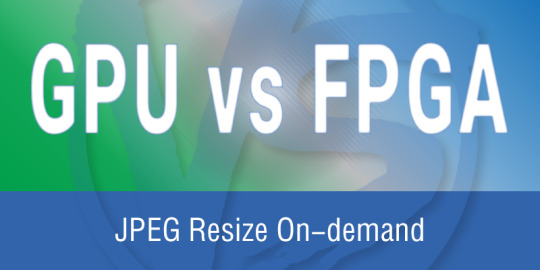
Internet traffic is increasing by ~25% annually (according to white paper from CISCO, see below) and images take considerable part of that data. Many companies are handling huge volumes of images in their data centers:
Cloud storage, CDN
Mobile instant messaging
Images for social networks, image social platforms, cloud albums, photo hosting centers
User-Generated Content platforms (UGC)
E-Commerce platforms
Market demand
Users generate more images and video data every day
User devices have higher resolution in capture and display
Users strive to better viewing experience
Better image quality and QoS
Customers demand instant access to the resource (reduced latency)
Challenges
Huge consumption of computational and storage resources
Server and storage performance is not enough
As a task for performance and latency comparison for FPGA vs GPU at image processing, we will consider JPEG Resize on-demand which is widely utilized in web applications. Total number of JPEGs in the world is absolutely huge and it's significantly increasing every day. That's why companies spend quite a lot on storages for these pictures and on hardware/software for image processing. The simplest approach is to store the same JPEG picture at several different resolutions and to send an image which is slightly bigger at each request. Such an approach can't match desired image resolution exactly. To cut the expences on storage and to respond to user faster, we can resize JPEG images in realtime according to necessary dimensions to accomplish full match with the requirements of user's device. In that case we need to store at datacenter just one original picture which will be processed according to individual request parameters. That idea about on-demand resize for JPEG images is not new and it has already been implemented in several internet services on CPU, GPU and FPGA.
Image processing pipeline for JPEG Resize on-demand
JPEG Decoding
Resizing and Cropping
Sharpening
Color profile handling
JPEG Encoding
That pipeline consists of different algorithms and we could hardly implement batch processing here for the whole pipeline, as soon as final dimensions are different, images could have different subsampling, individual quantization tables and Huffman tables. It means that we have to process these algorithms sequentially, though still there is a possibility to get a boost from batch mode. Most of the time in the pipeline is spent on JPEG Decoding, so we could implement batch just for JPEG decoding. We can prepare images for future batching by utilizing the same subsampling, quantization tables and Huffman tables. File size will increase a little bit, but we will get an opportunity to accelerate JPEG decoding.
Image Processing on FPGA
FPGA (Field Program Gate Array) is a specialized reconfigurable hardware which could be also utilized for fast image and video processing. This is very complicated approach for programming and FPGA engineers should know quite a lot: hardware architecture, Verlog or VHDL language, Intel (Altera) or Xilinx development tools, etc. Total understanding of hardware functioning is a must, so not everyone could do that. Still, that approach is evolving rapidly and there are some outstanding results in that field.
FPGA-based solutions posess some features which could hardly be beaten: hardware-based computations are usually very fast, the hardware could have very low dimensions and it could have extremely low power consumption. These are indispensible conditions for many embedded applications. In comparison with FPGA, any CPU or GPU-based solutions have bigger dimensions and need more power for processing with the same performance.
Despite the fact that FPGA-programming is very complicated, there are quite a lof of imaging solutions which are based on FPGA/ASIC hardware. Moreover, neural networks have already been implemented on FPGA and that hardware platform is considered to be very promising for Deep Learning and Artificial Intelligence tasks. Currently, neural networks are much more easier to implement on GPU, than on FPGA. But FPGA is a competitive solution, though at the moment it requires super high skills to work with.
Some frame grabbers have built-in library for internal FPGA-based image processing. Silicon Software framegrabbers (now belongs to Basler company) have such a feature and this is the way to implement FPGA-based image processing for camera applications without writing any code on VHDL or Verilog. This is important task to ensure faster than realtime image processing on FPGA for high speed and high performance cameras.
CTAccel solutions on Intel FPGAs
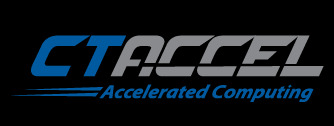
CTAccel company is based in Hong Kong and Shenzhen. This is a team of FPGA professionals with solid record of achievments in FPGA design, hardware/software co-design, system optimization and software engineering. The core team of CTAccel comes from the FPGA team of Clustertech Ltd.
CTAccel Image Processing Solutions
CTAccel Image Processor (CIP) effectively accelerates the following image processing/analytics workflows:
Thumbnail Generation/Transcoding
Image processing (sharpen/color filter)
Image analytics
CIP includes the following FPGA-based accelerated functions:
Decoder: JPEG
Pixel processing: Resize/Crop
Encoder: JPEG, WebP, Lepton
Software compatibility with OpenCV, ImageMagick and Lepton
CIP Image Processing Pipeline (image from that PDF)
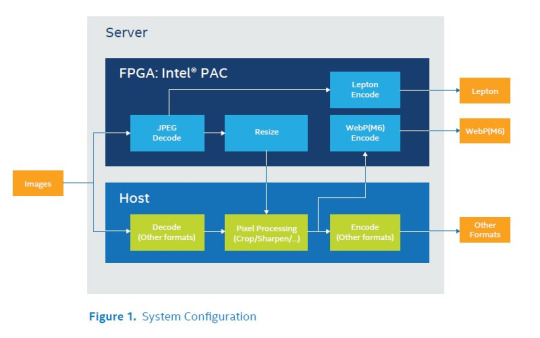
That diagram for suggested image processing pipeline shows that Crop, Sharp and Color conversions are implemented on Host CPU, not on FPGA. In that case we get combined heterogeneous solution, where image processing is done both on FPGA and CPU. This leads to additional load for CPU.
Intel FPGA board (image from that PDF)
The CIP accelerator features an Intel® Programmable Acceleration Card (PAC) with Intel Arria® 10 GX FPGA.
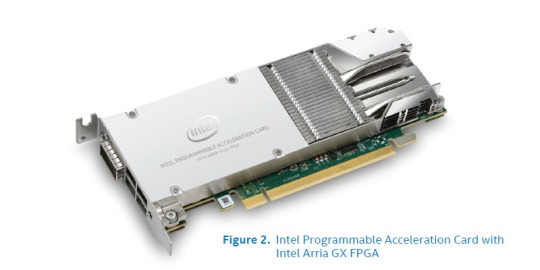
Performance evaluation for CTAccel CIP solution on Intel PAC
JPEG Resize solution from CTAccel for Intel® Programmable Acceleration Card can do JPEG decoding, image resize and JPEG encoding. This is the screenshot for Real-world customer use case from CTAccel site:
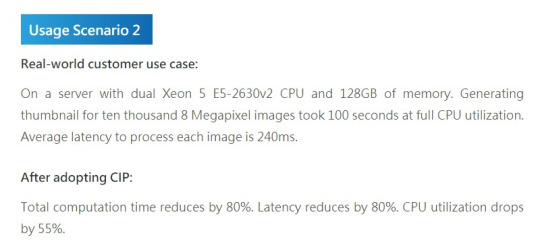
8 MPix image is converted to thumbnail on Intel Xeon E5-2639 v2 CPU within 10 ms (100 sec / 10,000 images), which means that on CTAccel CIP that image could be processed within 2 ms (total computation time 10 ms reduced by 80%). For further comparison we can conclude that 3 MPix jpeg image could be resized on Intel PAC with CTAccel CIP within 0.8 ms which is equal to 1250 fps (frames per second).
Averaged latency for 3 MPix image processing on FPGA is the following: (240 ms * (100 - 80) / 100 * 3 / 8 = 18 ms. This actually means that FPGA is processing around 18 / 0.8 = 22 images at the same time. It looks like a batch mode for JPEG decoding on CIP has already been implemented.
Unfortunately we don't have full info about parameters for that pipeline. Nevertheless, we can expect that original compressed image should be close to visually lossless compression. "Generating thumbnails" approach means that final image resolution is very small, so applied resize takes less time and output JPEG encoding takes almost no time. In real-life case of JPEG Resize on-demand we need to fit resolution of smartphone screen, and this is more computationally intensive (that scenario was used for tests with NVIDIA Tesla T4 GPU). Still, these performance results could be a ground to make indirect comparison with benchmarks on NVIDIA Tesla T4. To the best of our knowledge, pricing for Intel PAC board and NVIDIA T4 is comparable.
XILINX

Xilinx Alveo, a portfolio of powerful accelerator cards designed to dramatically increase performance in various tasks. Xilinx® Alveo™ U280 Data Center accelerator cards are designed to meet the constantly changing needs of the modern Data Center. Built on the Xilinx 16nm UltraScale™ architecture, Alveo U280 ES offers 8 GB of HBM2 410 GB/s bandwidth to provide high-performance, adaptable acceleration for memory-bound, compute intensive applications including database, analytics, and machine learning inference. The U280 ES acceleration card includes PCI Express 4.0 support to leverage the latest server interconnect infrastructure for high-bandwidth host processors. And like all Xilinx technology, customers can reconfigure the hardware, enabling them to optimize for shifting workloads, new standards and updated algorithms without incurring replacement costs.
Alveo accelerator cards are adaptable to changing acceleration requirements and algorithm standards, capable of accelerating any workload without changing hardware, and reduce overall cost of ownership.

Xilinx Alveo U280 Data Center accelerator card (image is taken here)
There are some libraries which allow to implement image processing algorithms on FPGA via C++ instead of Verilog/VHDL, though finally VHDL code will be generated. Xilinx Video and Image Processing Pack is an example how to do that. It includes full licenses to the following LogiCORE IP cores:
Chroma Resampler
Color Correction
Color Filter Array Interpolation
Gamma Correction
Image Edge Enhancement and Image Noise Reduction
On-Screen Display
Video Deinterlacer
Video DMA
Video Timing Controller
The Xilinx Video and Image Processing Pack provides bundled licensing option for all of the LogiCORE™ IP blocks. Video processing blocks provide optimized hardware implementations for video scaling, on-screen display, picture-in-picture, text overlay, video and image analysis and more. Image processing blocks enable pre-processing of images captured by a color image sensor with a Bayer Color Filter Array (CFA), correcting defective pixels, interpolating missing color components for every pixel, correcting colors to adjust to lighting conditions, setting gamma to compensate for the intensity distortion of different display devices and more.
CTAccel on Virtex UltraScale+ VCU1525
The above set of image processing features from Xilinx LogiCORE IP cores is not enough to accomplish the task of JPEG Resize on-demand. That task was solved on Xilinx FPGA hardware by CTAccel company, as in the case with Intel FPGA. That solution from CTAccel on Xilinx is utilized by Huawei Cloud for FPGA Image Transcoding Acceleration on Virtex VU9P to provide easy-to-use and cost-effective image transcoding services. For the task of thumbnail generation (which is alike the task of JPEG Resize on-demand, but more simple), published benchmarks for performance and latency are the same as for Intel FPGA solution - this is 0.8 ms for 3 MPix jpeg image. It should be noted that the same CTAccel CIP solution can work on Xilinx Alveo accelerator cards as well.
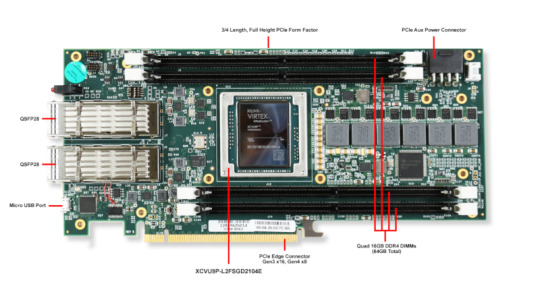
Xilinx VCU1525 developer board (image is taken here)
GPU Image Processing on NVIDIA CUDA
GPU architecture was initially created for image display and finally it was transformed for parallel computations. Image processing could be considered as native task for GPU, though we need SDK not to program GPU at low level. There are quite a lot of such SDKs with sofisticated set of features.
Full set of features for JPEG resize on demand exists at Fastvideo Image Processing SDK. That SDK contains wide variety of image processing modules which show very high performance at all NVIDIA GPUs, starting from Jetson to high-end Quadro and Tesla products. Highly optimized modules show just exceptional results. For many features the performance is much higher that bandwidth of PCIe Gen3 x16. This is important issue to offer fast solution, particularly for JPEG resize on demand.
That solution has been heavily tested for years and this is the proof of its reliability in the taks of JPEG Resize on-demand. Several high-load internet services have been utilizing that software and total number of processed JPEGs exceeds several quadrillions. In comparison with recently developed FPGA-based solutions it looks much more reliable.
Fastvideo Image Processing SDK on NVIDIA T4 can do decode-resize-sharp-encode at 1.2 ms for 3 MPix image resize which is around 800 fps, but this is the result without batch mode. As soon as image resize on GPU takes small part of that time, we see that performance on JPEG Decoder is the key to achieve maximum speed for that task. Usually resized image has smaller resolution and output JPEG Encoder can process it very fast. In general, GPU JPEG Encoder is much faster than GPU JPEG Decoder, that's why JPEG decoding is the bottleneck for that task.
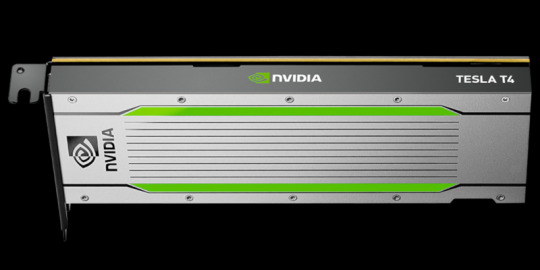
Despite the fact that we haven't yet implemented our own batch mode for JPEG Resize on-demand, there is an opportunity to increase GPU occupancy with CUDA MPS on Linux. CUDA MPS allows to utilize NVIDIA Hyper-Q technology in multi-process environment and this is the way to get much better performance if GPU is underutilized (this is exactly our case). We have run 4 processes of JPEG Resize on-demand on NVIDIA T4 and have achieved significant speedup with CUDA MPS. We've got final performance 2200 fps with CUDA MPS on NVIDIA Tesla T4.
The feature of FPGA partial reconfiguration doesn't bring any additional benefits in comparison with GPU solutions for high performance image processing tasks. Basically, the performance is defined by the hardware and software. And if we need to run any other task on the same hardware, we just need to load another software from available image processing modules. In the case with GPU, this is actually a question about availability of necessary modules in the software. Fastvideo Image Processing SDK has great variety of such modules and it can also work with any other third-party SDK, so the choice of available software features for CUDA image processing on Tesla T4 is impressive.
It should be noted that currently, versatility of GPU is much more profound in comparison with FPGA. NVIDIA GPUs have a lot of libraries which help developers to build their applications. And the idea of utilizing COTS (Commercial Off-The-Shelf) is very handy. GPU and FPGA have totally different architectures and that's why their "killer applications" are also quite different. NVIDIA, Intel and Xilinx invest a lot into their software, hardware, infrastructure, community and try to promote their solutions at full extent. They do compete everywhere and NVIDIA is now succeeding with implementation of embedded solutions on Jetson platform, though embedded solutions were always the main market niche for FPGA/ASIC. Intel and Xilinx are moving towards DL/AI to compete with NVIDIA as well.
Conclusions
We have published available results for GPU vs FPGA performance and latency for JPEG Resize on-demand task. That comparison is indirect because we have benchmarks for different scenarios: for FPGA this is thumbnail generation case for JPEG images, for GPU this is standard JPEG resize to most frequently used resolution which was acquired from statistics.
Achieved performance for the above tasks look very good in both cases: NVIDIA Tesla T4 result is around 2200 fps for JPEG Resize with CUDA MPS. Intel/Xilinx result is around 1250 fps for thumbnail generation with internal batch decoding, which is more simple task because it requires less computations. We can see that NVIDIA Tesla T4 significantly outperforms Intel/Xilins FPGA boards and we need to bear in mind that FPGA benchmarks were received in simplified test.
Computational latency in these tasks for NVIDIA Tesla T4 is 2-3 ms, for FPGA this is 18 ms.
FPGA dimensions and power consumption are not vitally important for JPEG Resize on-demand task. FPGA boards look like GPU boards and their dimensions are the same, though power consumption is still less for FPGA-based solutions which have 20W - 40W per FPGA card and 70W for NVIDIA Tesla T4.
Ease of programming is also looks alike, because mostly developers are utilizing high-level SDKs. If we have a look at low-level programming, then FPGA is much more complicated to handle.
Partial Reconfiguration and flexibility are essential benefits of FPGA, but for the current task they are not really important.
Reliability of GPU-based solution is higher due to long-term presence on the market.
Both GPU and FPGA could be utilized for other tasks, including DL/AI applications.
GPU-based solutions are basically software implementations, though FPGA solutions imply that there is non-standard hardware to work with. This is a great advantage of NVIDIA GPUs - they are commodity things. At the moment we can't call FPGA-based boards from Intel and Xilinx as commodity things yet.
NVIDIA, Intel (Altera), Xilinx, CTAccel, Fastvideo are great companies which move progress forward and create impressive software and hardware solutions for high performance applications.
What we finally get
GPU and FPGA high-performance processing capabilities offers the following benefits:
Increased image processing throughput
Reduced TCO
Reduced computational latency
Reduced size of cluster or less total number of servers
Low CPU utilization
Better user experience and QoS:
Less time to wait for image loading
Less power consumption on users's device
Less traffic due to optimal image resolutions
Better image quality (no local image resize on user's device)
Links
Cisco Visual Networking Index: Forecast and Trends, 2017–2022 White Paper (Internet traffic growth estimation)
JPEG Resize on-demand on NVIDIA Tesla V100 with Fastvideo software
Accelerating JPEG, WebP and Lepton decoding, encoding and resizing on Intel® Xeon®-based servers by offloading all functions to the Intel FPGA.
Xilinx Alveo U200, U250 and U280
Xilinx Video and Image Processing Pack
NVIDIA Tesla T4 specification
Fastvideo Image Processing SDK for NVIDIA Tesla GPUs
Jpeg2jpeg Acceleration with CUDA MPS on Linux at NVIDIA Quadro GV100
Original article see at:
0 notes
Text
What is the career path of an ASIC verification engineer?
The career path is generally determined by the individual’s interest, knowledge, and passion towards the field. To begin with, the VLSI industry always depends on the trends of the electronics industry. Every major development in technologies and electronic products has led to the creation of complex circuits. About the verification process, it includes functional design and verification, physical design and verification, packaging, and manufacturing test. It is very essential to verify the circuit design, its performance and function to ensure that the chips are working as per the purpose and design. Over the years, chip design technology has greatly evolved both in terms of function and design. Therefore, based on the chip design, ASIC verification can be simple or highly complex. A professional who has completed an ASIC verification course will have the knowledge and expertise to manage simple to complex design verification projects.
How difficult is it to become an expert in Verification Domain?
It is quite difficult to become an expert in the verification domain. The first reason is that it is a very complex domain. Below are some of the skills that are expected from a Verification expert:
● Professionals need to have expertise in software programming.
● Plus, they should have in-depth knowledge and understanding of the various ASIC verification concepts including stimulus and modelling workbench.
● Aspirants in this domain should also know about sound hardware and the types of verification.
● As for the soft skills, the professionals need to have good critical thinking skills that will help them evaluate the design and identify possible defects in the design and the chip.
● The verification engineers should also have logic design reasoning skills that will help them get a deep understanding of the micro-architecture of the design.
● They should be able to work on product design, product architecture, software development and verification.
● Plus, they should have the skills to interact with the customer to understand their product requirements and purposes.
How to stay updated about the latest trends in ASIC?
The best way to stay updated about the latest trends in ASIC is to sign up for industry newsletters and magazines. It is also a good idea to join online VLSI training to learn the latest advancements from the experts.
Job Opportunities as a Verification Engineer
Though there are a lot of opportunities and vacancies, the semiconductor industry hires only the skilful engineers. Especially in the ASIC design verification, a niche domain that needs only highly skilled and expert professionals. The various job opportunities that you can explore in this domain are:
· Performance verification engineer
· Power aware verification engineer
· Clocking and CDC verification engineer
· DFT/DFM verification engineer
· FPGA Emulation engineer
· HW/SW Co verification engineer
· Functional verification (Simulation and formal verification) engineer
Get ASIC Verification Training at Maven Silicon
Maven Silicon is one of the top online VLSI training institutes that offers job-oriented courses for students and professionals. They offer intensive ASIC verification courses that cover the most important concepts including system Verilog, formal verification, design verification and SOC design. Their students work on real-time verification projects as a part of their online VLSI training. Working hands-on in projects will help students gain confidence and expertise to manage the real work projects. Maven Silicon offers placement support through a dedicated team, which helps the trainees to grab the job opportunities in leading semiconductor companies. They also share the latest job alerts with students as a part of the placement services. Interested in building your career as a verification engineer? Sign up for a course at Maven Silicon, the VLSI training institute today.
0 notes